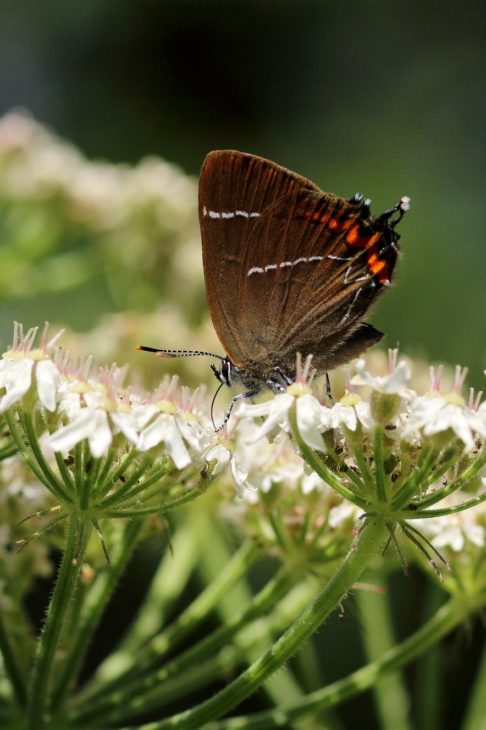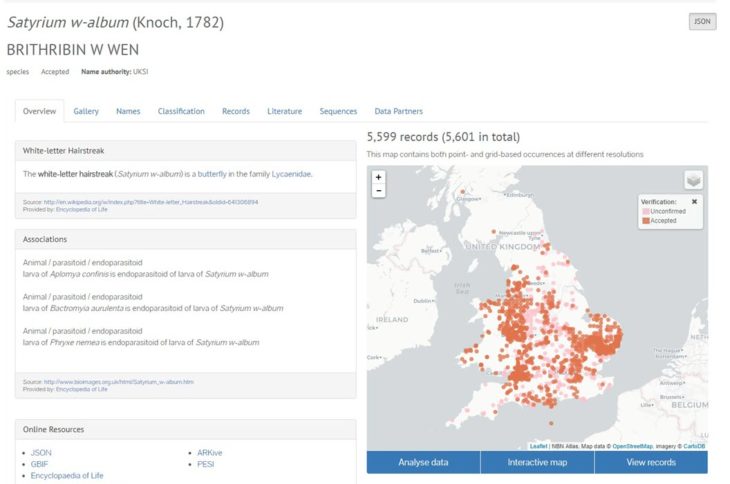One of the opportunities presented by the geography of living in Berwickshire on the border with England is an increased likelihood of recording a ‘First’ sighting for your county / country. Tracking the arrival of the White-letter Hairstreak butterfly in Scotland is clocking up several Firsts.
In August 2017, Iain Cowe, Butterfly Conservation’s Borders Butterfly Recorder, discovered a rather bedraggled adult butterfly at Paxton, the First recent evidence that the butterfly was indeed in Scotland. A search for eggs commenced and that winter the First evidence of eggs was discovered at several nearby sites.
By spreading the word, Iain got the message out that the hunt was on for adult butterflies flying this summer. The key details were: their flight period is July-August and the butterflies are elusive, living their entire life in the very top of elm trees, although after rain they may be seen at ground level looking for nectar on for example Ragwort, Thistle and Bramble 1.
Roll on to 30 June 2018 and in my garden an unusual looking butterfly is seen taking water from a puddle next to the garden hose. It is caught, and we identify it as a White-letter Hairstreak. Another First – this time for our garden!
A brief email is sent to Iain for verification. We are thinking that this cannot actually be the First for Berwickshire / Scotland this year, but Iain’s response tells us otherwise – he is literally speechless (it comes over in email, honest!). He verifies that it is a White-letter Hairstreak, it is the First to be recorded this year, and is an adult male in pristine newly-emerged condition, probably from a population in our elm tree. It is also a First for our 10km square in Scotland!
This sighting is added to the First Sightings table on Butterfly Conservation’s East Scotland Branch website and provided an impetus for further exploration. And indeed, Iain has confirmed that when he checked the other egg sites, the White-letter Hairstreak is found in flight. Result! The butterfly has arrived and has been breeding in Scotland at least this year, if not for longer.
So what does all this demonstrate?
Recording a ‘First’ is a bit of fun but it does add a light touch to the engagement of recorders in the rather more serious business of contributing to our understanding of species distributions. It is important that we know what to look out for so that we can record what we have and understand what is moving in or out of an area. This information can be used to ensure our actions will not have a negative impact or used as the starting point for looking at the reasons for change.
It also demonstrates that providing some basic information about what to look out for enables more recorders to be informed and on the lookout. These last two points raise the interesting question as to how long the species might have been present – might it have been here some time but we just have not noticed it?2 Notwithstanding all this, there has been a lot of interest in the sightings of this butterfly and it is now hoped that eggs will be found in elm trees this winter.
I’d like to take this opportunity to thank Iain Cowe for the energy and commitment he puts into recording, verification and recorder engagement. It is voluntary effort that is greatly appreciated and very worthwhile, and it is recognised that this effort is essential if we want to maintain and expand our understanding of butterfly distributions. Effort like this is replicated by verifiers across the country for many different taxon groups and it is sobering to think that without it, we would not have the databases of records that are used to inform decision-making, and which can be shared on platforms such as the NBN Atlas.
Written by Christine Johnston, NBN Scottish Liaison Officer
Footnote
1,2 The primary source of information about the discovery of eggs and the ecology of the White-letter Hairstreak is an article by Iain Cowe A New Universe found on the tip of a Branch in Borders Newsletter, Issue 20, Spring 2018, published by Butterfly Conservation Scotland.

You can see the distribution of the White-letter Hairstreak butterfly as shown on the NBN Atlas with a snapshot on the map below

